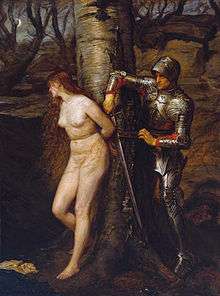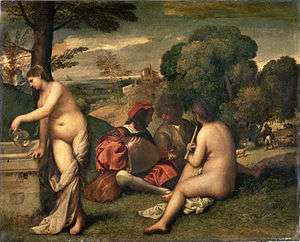Clothed male, naked female

Clothed male, naked (or nude) female is female nudity in which one or more women are nude while one or more men are clothed. The scenario is sometimes abbreviated to CMNF.
Objections
Feminists argue that such images "are objectionable, and objectify women". However, the same can be argued for the case of males, for example with CFNM.
In media
Entertainment columnist Earl Wilson details several experiences involving one-sided female nudity in his book Show Business Laid Bare.[1] In the chapter titled "Cheri Caffaro: A Strange Interlewd," Wilson writes about his experience interviewing actress Cheri Caffaro while she was nude and he was fully dressed.[2]
As a theme in art
 The Slave Market, Jean-Léon Gérôme, c. 1884
The Slave Market, Jean-Léon Gérôme, c. 1884_-_01.jpg) Phryne before the Areopagus, Jean-Léon Gérôme, 1861
Phryne before the Areopagus, Jean-Léon Gérôme, 1861 Slave market in Rome, Jean-Léon Gérôme
Slave market in Rome, Jean-Léon Gérôme_(1).jpg) Le déjeuner sur l'herbe, Édouard Manet, 1863
Le déjeuner sur l'herbe, Édouard Manet, 1863 John Everett Millais' Knight Errant of 1870 saves a damsel in distress and underlines the erotic subtext of the genre
John Everett Millais' Knight Errant of 1870 saves a damsel in distress and underlines the erotic subtext of the genre The Pastoral Concert Titian, c. 1509, has been cited as an inspiration for Manet's painting
The Pastoral Concert Titian, c. 1509, has been cited as an inspiration for Manet's painting La Femme entre les deux âges, c. 1575, painter unknown
La Femme entre les deux âges, c. 1575, painter unknown.jpg) Adoration, William Strang, 1913
Adoration, William Strang, 1913
One-sided female nudity has been a theme in art, particularly in Orientalist paintings of the 19th century. A typical scene may be a depiction of white slavery in which one or several nude women are displayed before an audience of men as part of a slave auction. The archetypal example of this type of scene is Jean-Léon Gérôme's The Slave Market, in which a nude female slave is examined by a potential buyer. Another example is Gérôme's Phryné devant l'Areopage (Phryne before the Areopagus, 1861) which was based on the trial of Phryne before the Areopagus in ancient Greece. The odalisque (harem scene) was also a popular subject for depicting one-sided female nudity, although the clothed figures in the scene were not always male.
Outside of the Orientalist style, a scenario for one-sided female nudity in 19th-century art was the knight-errant, in which the damsel in distress was used to explore the erotic subtext of the powerful knight coming to the rescue of a helpless woman. The best known example of this is John Everett Millais' painting Knight Errant, in which a nude woman has been tied to a tree and a knight is shown cutting her loose.
Another example is Édouard Manet's Le déjeuner sur l'herbe ("The Luncheon on the Grass"), in which a nude woman is depicted having lunch with two fully clothed men. The Pastoral Concert (c. 1510) attributed to Giorgione or his pupil Titian[3] has been cited as an inspiration for Manet's painting.
A 1913 painting Adoration by William Strang presents a philosophical study of beauty, with the clothed soldier, painter, scholar, and elderly gentleman fascinated by the naked female subject.
See also
- Bottom (BDSM)
- Candaulism
- Clothed female, naked male
- Erotic humiliation
- Exhibitionism
- Female submission
- Nyotaimori
- Voyeurism
References
- ↑ Show Business Laid Bare, by Earl Wilson, ISBN 0-399-11276-6, New York, G. P. Putnam's Sons, 1974. Second Printing
- ↑ The story can be found on pages 45-56 of the hardcover second printing of the book.
- ↑ From the Louvre Museum Official Website Archived June 28, 2009, at the Wayback Machine.
External links
-
 Media related to Clothed male, nude female at Wikimedia Commons
Media related to Clothed male, nude female at Wikimedia Commons
| Look up CMNF in Wiktionary, the free dictionary. |